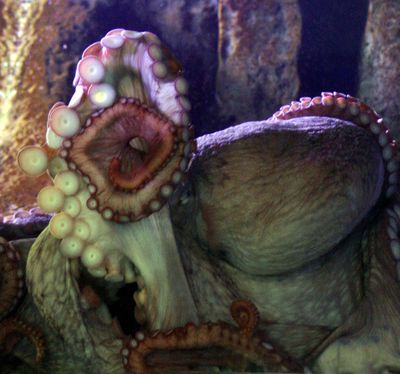Alaska’s SeaLife Center gets 3rd baby octopus raising chance

KENAI, Alaska – Alaska’s SeaLife Center is getting its third shot at raising thousands of octopus hatchlings, hoping at least one of the translucent mollusks will grow into its 50-pound, color-changing form.
Such a task has been completed just once before – by the Seattle Aquarium in the 1980s, the Peninsula Clarion reported. The aquarium won an award in 1982 for successfully raising the giant pacific octopus.
The SeaLife Center had hatchlings twice before, in 2005 and 2013. This time, the center’s octopus named Gilligan, named after the 1960s TV show “Gilligan’s Island,” has raised about 100 eggs into hatchlings with more to come.
The center said giant pacific octopuses usually lay a clutch of between 20,000 to 80,000 eggs, from which about 1 percent of the young survive in the wild. Success rates are even lower in captivity due to hatchlings’ fragility.
For about a year, the hatchlings will remain afloat, translucent except for their large eyes and the colored spots of their chromatophores – cells that octopuses can open and close to change color.
“In the ocean, it’s vast – there’s a bottom and a shore, but realistically they’re not going to bump into anything,” SeaLife Center aquarist Chuck Dimarzio said. “You put them in a tank, regardless of its size, and they inevitably end up against the walls of that tank, and the way they move is by sucking water in and pushing it out – so they’re constantly bobbing up down. If they end up against the tank wall, their mantles are fragile, and they’ll abrade them.”
Dimarzio said the staff might try to avoid this danger by using a cylindrical tank with circular flow around the walls.
“The realistic goal is to learn more than we knew from our previous attempt at this – just to refine further our culture techniques for these animals, from tank design, tank shape, playing with different flow systems, and experimenting with different feeding regimens as well.” Dimarzio said.
Octopuses only reproduce at the end of their lives, and after sitting on her eggs for nearly a year, blowing water over them to keep them clean, Gilligan is expected to die in a few months.
“We do feed her regularly, but she kind of loses interest in food,” Dimarzio said.
Gilligan is around 30 pounds now, but weighed about 50 pounds when she laid her eggs.
Male octopuses are able to mate dozens of times within the few end-of-life months they become fertile. The father, Leo, died a few months after impregnating Gilligan in December 2017.
Gilligan, her eggs, and the hatchlings are on public display in the SeaLife Center’s “Octopus Grotto” exhibit.